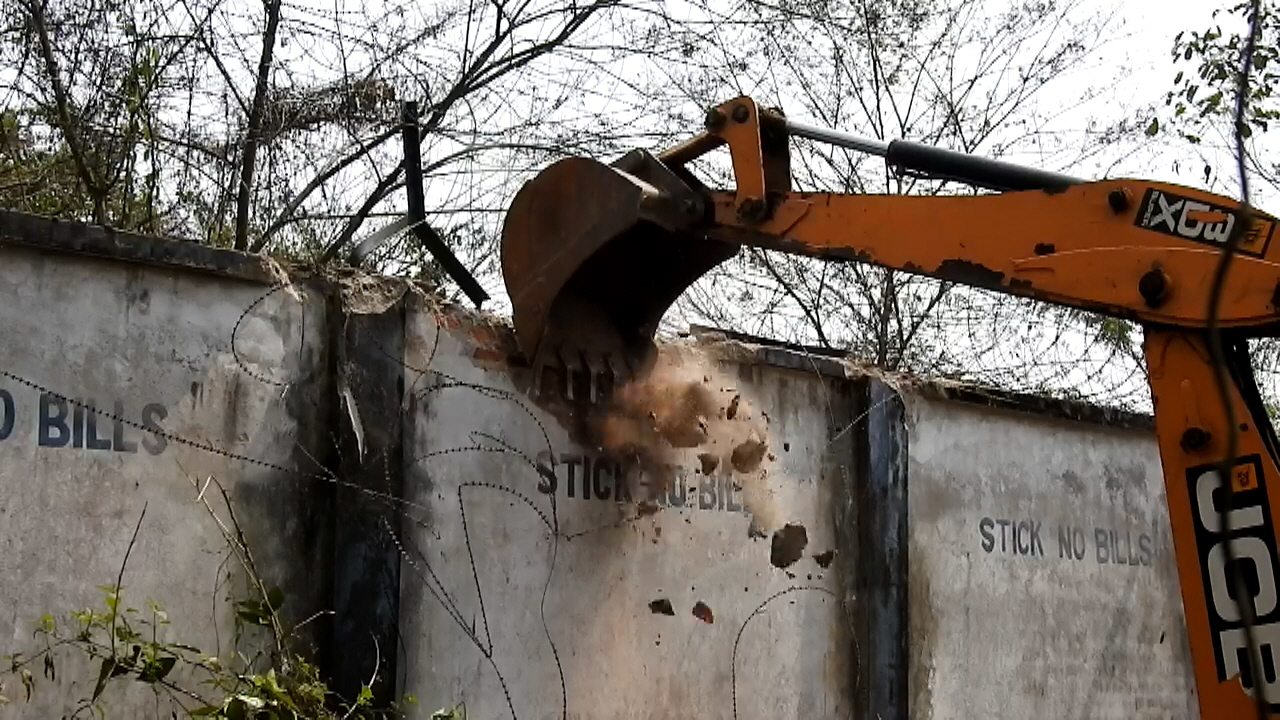- On March 13, officials tore down a 289-meter (948-foot) stretch of a 2.2-kilometer (1.4-mile) concrete wall built by an Indian oil refinery, allegedly blocking an elephant corridor.
- In August 2016, India’s National Green Tribunal (NGT) — tasked with ensuring the speedy disposal of environmental cases — ordered NRL to demolish the entire length of the wall within a month.
- But only a 289-meter-stretch was demolished, reportedly because that stretch encircled an area of land that fell within a proposed reserved forest. The case is ongoing.
Environmental activists in India have expressed dismay at the partial demolition of a wall built by an oil refinery that they hoped would be completely pulled down. The wall, they contend, blocks an important elephant corridor out of a national park.
Officials on March 13 tore down a 289-meter (948-foot) stretch of the 2.2-kilometer (1.4-mile) concrete wall built in 2011 to mark the boundary of a proposed township to be set up by Numaligarh Refinery Limited (NRL), a joint venture between Bharat Petroleum, Oil India and the government of the state of Assam.
Erected to fence off the company’s housing estate and a golf course, the wall became the center of controversy in 2015. In May that year, forest officials found a 7-year-old male elephant that had reportedly died of “severe hemorrhage” from violently thrusting against the wall. The same year, environmentalists captured videos showing elephants trying to cross the high boundary wall.
A campaign to tear down the wall, led by the environmental activist Rohit Choudhury, appeared to be successful when, in August 2016, the National Green Tribunal (NGT) — tasked with ensuring the speedy disposal of environmental cases — ordered NRL to demolish the entire length of the wall within a month.
The demolition earlier this month, Choudhury told Mongabay, was carried out only after he filed yet another plea with the NGT in November 2017, highlighting the failure to execute the NGT’s orders — something that could incur penalties for NRL and state government officials.
The case is, however, still ongoing because NRL filed a review petition. Madhuchanda Adhikari, an NRL spokesperson, said in an email that the company was not in a position to comment on the wall pending the review at the NGT. She added that “no declared elephant corridor exists in the boundary wall site.”

No-development zone
Environmentalists, however, maintain that NRL’s wall is problematic because it lies right in the path of a traditional elephant corridor.
Adjoining the refinery is Deopahar, a forested hill that acts as an important migratory route for elephants and other wild animals moving out of Kaziranga National Park. Kaziranga is home to the world’s largest population of the one-horned rhinoceros (Rhinoceros unicornis).
The environmentalists also say that the wall, the NRL township and the golf course are being built illegally in a “No Development Zone” declared by the Ministry of Environment, Forest and Climate Change (MoEF) in 1996.
The 2016 NGT judgment concluded that a part of NRL’s proposed township overlapped with the area carved out for the Deopahar Proposed Reserve Forest. In a 1999 notification, the government of Assam described the proposed reserve area as being “rich in wildlife,” including elephants, jungle cats, leopard cats, squirrels, pythons and many other varieties of snakes and birds. The area also “provides shelter to the migratory animals of the Kaziranga National Park,” the notification said, adding the forest was a “regular migratory route of elephants.”
Given the ecological importance of the area, the tribunal ordered that NRL not build its township in the proposed area. The NGT also ordered the government of Assam to formalize, under state regulations, the Deopahar Proposed Reserve Forest as a reserved forest, which would afford it greater protections.
The portion of wall that was recently demolished was targeted based on a survey by the forest department, according to Rajib Kumar Das, divisional forest officer (DFO) for the jurisdiction of Golaghat. The survey results showed that two sections of the wall, running 174 and 115 meters (571 and 377 feet), encircled an area of land that fell within the Deopahar Proposed Reserve.
“We are not concerned with the wall,” Das said. “We are only concerned with that one hectare [2.5 acres]. That land had to be freed to be declared as part of the reserved forest, and we are trying to declare Deopahar as a reserved forest as fast as possible.”
Choudhury said this was unsurprising. “I am glad that the DFO has accepted that one hectare of land was under the occupation of NRL,” he said. “It proves that NRL, which was the winner of Greentech Gold Award for outstanding achievements in Environment Management in 2017, has encroached upon forest land of Deopahar Proposed Reserve Forest.”

